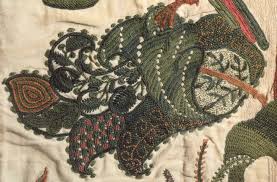Ancient Hand Embroidery Technique Reinvents Itself over Time
From the Bayeux Tapestry to modern floral wall hangings, crewel stitches worked with embroidery wool on the woven fabric have been an enduring hand embroidery tradition.
Crewel work is a form of embroidery that uses wool yarn to stitch a design drawn on a background fabric. Linen twill is the traditional background fabric for crewel work. Flowers, vines, leaves, and birds are all traditional crewel embroidery motifs.
“Crewel” Derives from Ancient Word for Wool Yarn or Thread
While the origin of the term “crewel” is murky, historians speculate that it may come from the medieval words “clew” or “krua,” which refer to a ball of yarn or worsted thread. Wool was one of the materials widely available to hand stitchers in the days when trade with distant lands was slow, difficult, and dangerous.
Crewel Embroidery as History, from the Bayeux Tapestry to the Quaker Tapestry
The most famous early example of crewel embroidery is the Bayeux Tapestry, a 230-foot (70 meters) long wall hanging that tells the story of the 11th century Norman Conquest of England. The tapestry was embroidered more than 900 years ago and can still be seen today in Bayeux, France.
Crewel work is still being used to create an enduring visual record of historical events. The modern-day Quaker Tapestry, begun in 1981 and completed in 1996, depicts the 350-year history of the Quaker religion. More than 4,000 people took part in the making of the Quaker Tapestry, which consists of 77 embroidered linen panels. The tapestry is on display in Cumbria, England.
Decorative Crewel Work in the Middle Ages and Renaissance
Crewel embroidery was popular across Europe through the middle ages. Surviving objects from the period that were decorated with crewel work include wall hangings to help cut down the chill in drafty and uninsulated rooms, clothing for both men and women, covers for beds, tables, and floors, chair seats, and numerous small everyday items. Silk threads and a variety of background fabrics were used for crewel work.
In those days, crewel was an art that belonged to the elite. Queens and high-ranking ladies of their courts embroidered flowers, fruits, animals, and other motifs drawn from nature on expensive silk, wool, linen, and velvet fabrics, using a huge palette of colors and often working with costly silk threads instead of embroidery wool.
Legend attributes the creation of the Bayeux tapestry to William the Conquerer’s wife, Queen Matilda of England (working with a large group of her ladies), although some historians now dispute this. Like many great ladies, Queen Elizabeth I of England was an accomplished embroiderer.
The development of steel needles in Germany paved the way for the expansion of crewel work from the court to guilds of professional craftsmen who embroidered for a living. In 1561, Queen Elizabeth granted a charter to the “Keepers and Wardens and Society of the Art and Mystery of the Broderers of the City of London.”
Jacobean Crewel Embroidery Patterns Take on Modern Form
During the reign of the English King James I, crewel work evolved to a form that would look familiar to modern stitchers. The tree of life design, with curving branches, blossoms, broad leaves, and birds and other wildlife perched in the branches, is typical of the Jacobean style. English embroidery of the era was influenced by designs from China and India; particularly the painted Indian wall hangings called palampores. Wool embroidery fell out of favor in the eighteenth century, perhaps because silk became more widely available.
Two American Crewel Embroidery Revivals
Crewel work came to the United States from England in the eighteenth century, at a time when a growing middle class of town dwelling women had enough free time to devote to decorative arts. Linen wedding dresses embellished with colored wool designs represent the some of the best of American crewel work of the period.
Crewel work fell out of favor again around 1800 as other forms of needlework such as lace making and crochet became more popular. Its latest large-scale revival occurred in the 1960s and 1970s, when all kinds of handmade crafts experienced a surge in fame in the United States, with renewed interest in both contemporary and traditional designs.
Today’s crewel embroidery offers stitchers great freedom in materials, subjects, stitches, and styles. It will be exciting to see what adjustments the next crewel revival brings to this ancient art form.
Sources for this article:
Springer, Jo. Pleasures of Crewel. Western Publishing Company, 1972. ISBN 0-307-09650-5
Coss, Melinda. The DMC Book of Embroidery. Collins & Brown, London, 1996. ISBN 1-85585-273-X.

